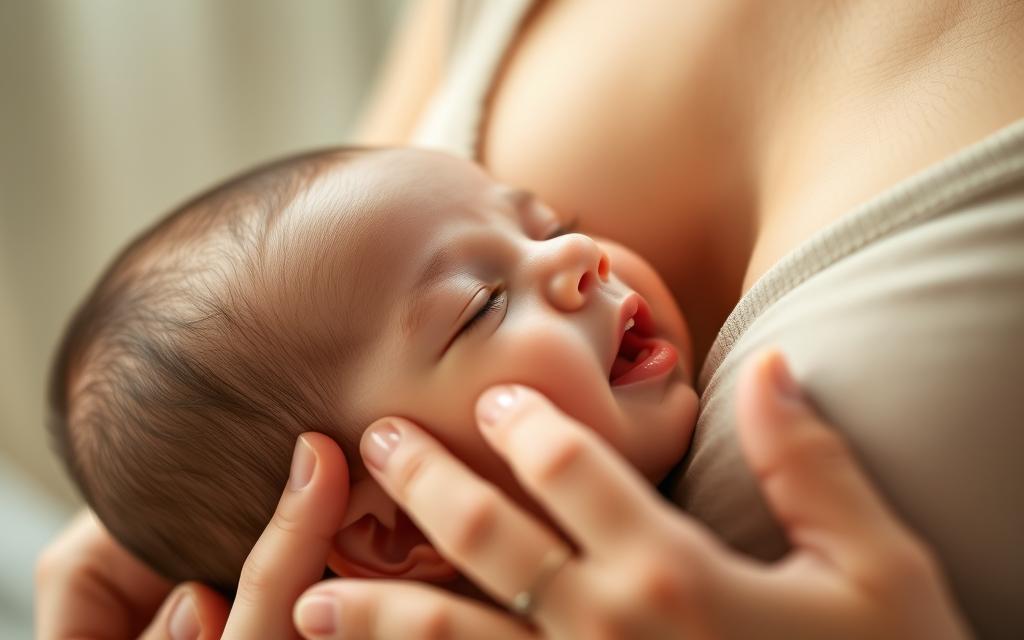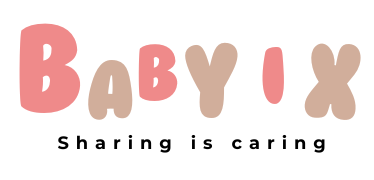Cracked Nipples While Breastfeeding: Causes & Solutions

Breastfeeding is a natural way to care for a newborn. But, it can be tough, with pain and sore nipples. About 90% of new moms face nipple pain, and 25% get cracked or bleeding nipples. But, with the right help, moms can keep breastfeeding and give their babies the best nutrition.
Cracked nipples are common but shouldn’t stop you from breastfeeding. Studies show that good attachment can cut nipple pain by 80%. Self-care and proper attachment can heal nipples faster by 50%. Knowing why nipples crack and how to fix it can help a lot.
Many moms face nipple pain and discomfort. But, it’s key to tackle these issues to avoid more problems. With the right advice and support, moms can beat cracked nipples and keep breastfeeding. This article will look at why nipples crack, how to prevent it, and how to find relief from pain and soreness.
Key Takeaways
- Approximately 90% of breastfeeding mothers experience some form of nipple pain during the initial weeks postpartum.
- Cracked nipples can be treated with emollient creams or breast milk, which have antibacterial properties.
- Proper positioning and latching can reduce the risk of nipple damage by up to 50%.
- Self-help measures, when combined with proper attachment techniques, can improve nipple healing rates by up to 50%.
- Using a breast pump with an improperly sized flange can contribute to nipple trauma, and it’s essential to avoid tight bras and harsh soaps to minimize friction and dryness on the nipples.
- Seeking help from a lactation consultant can provide personalized recommendations to enhance comfort and reduce nipple trauma.
Understanding Cracked Nipples During Breastfeeding
Cracked nipples, or nipple fissures, are common among breastfeeding moms. About 70-90% of them face nipple pain or discomfort. But, with the right support and care, you can manage the pain and keep nursing.
Knowing the signs of cracked nipples is key. Look out for pain, soreness, and bleeding. These symptoms mean you need help fast to avoid more problems. Important factors include:
- Improper latch and positioning, which causes 90% of nipple pain
- Choosing the right flange size, which cuts nipple trauma by 50%
- Fungal infections, like thrush, which affect 15-20% of breastfeeding moms
Good nipple care can speed up healing by up to 50%. Using lanolin or breast milk helps. Warm, moist heat also soothes sore nipples and aids in healing. Most nipple cracks heal in a few days to a week with proper care.
By understanding and addressing cracked nipples, breastfeeding moms can avoid complications. This way, they can keep nursing their babies without discomfort.
If nipple pain or issues don’t go away, get help from a healthcare provider or lactation consultant. With the right advice and support, you can overcome nipple soreness and have a successful breastfeeding experience.
The Impact of Cracked Nipples on Breastfeeding Journey
Cracked nipples can really hurt a mother’s breastfeeding journey. They cause nipple pain and discomfort. This can make it harder to keep up milk supply.
Studies show up to 90% of breastfeeding moms face some nipple pain. Cracked nipples are a big part of this. Bad latching techniques often lead to this problem.
Starting a breastfeeding journey can be tough, with nipple pain being a big hurdle. But, with the right help, moms can keep going. It’s key to get help fast to avoid more problems.
- Improper latching techniques
- Nipple pain and discomfort
- Decrease in milk supply
- Anxiety and stress
Knowing these factors and getting the right support can help. Moms can beat the challenges of cracked nipples. This way, they can keep breastfeeding and have a healthy breastfeeding journey.
Common Causes of Cracked Nipples While Breastfeeding
Many breastfeeding moms face cracked nipples, leading to pain and soreness. Knowing why nipples crack helps moms prevent it and get help fast. A big reason is an incorrect latch, which pinches the nipple against the hard palate.
Other reasons include breast engorgement, skin issues, and infections. Dry air or cold can make it worse. Learning the right latch is key to avoiding soreness and pain.
- Incorrect latch technique
- Breast engorgement
- Skin conditions and infections
- Environmental factors
Being aware of these causes helps moms avoid cracked nipples. Good latch and care can lower the risk of soreness and pain. This makes breastfeeding easier and more comfortable for both mom and baby.
Proper Breastfeeding Techniques to Prevent Nipple Damage
Using the right breastfeeding techniques is key to avoiding nipple damage and sore nipples. It’s important to make sure the baby’s mouth covers more than just the nipple. This is done by mastering the correct latching techniques.
Choosing a comfortable breastfeeding position, like the football or cradle hold, can also help. Nipple care is also essential. Mothers can use nipple shields or breast shells to protect their nipples. Remember, how often or long you breastfeed doesn’t cause sore nipples if the baby is latched right.
Here are some important tips for proper breastfeeding techniques:
- Ensuring the baby’s mouth covers a large portion of the areola
- Using a comfortable breastfeeding position
- Practicing good nipple care, including the use of nipple shields or breast shells if necessary
By following these tips and focusing on proper latching, mothers can avoid nipple damage. This ensures a healthy breastfeeding experience. Good breastfeeding techniques and care for the nipples are vital for a successful breastfeeding journey.

Essential Prevention Methods
Keeping nipples from cracking is key for a good breastfeeding journey. Using the right breastfeeding techniques, taking care of your nipples daily, and keeping your breasts clean can help. Studies show that about 1 in 3 moms get sore nipples because of how they hold their baby.
Start a daily routine for your nipples. Clean and moisturize them, and use a barrier cream to shield the skin. Keeping your breasts clean with mild soap and water can prevent infections. Also, pick nursing supplies like a comfy bra and breast pads to ease nipple pressure.
Some key ways to prevent cracked nipples include:
- Letting the baby come off naturally to avoid nipple damage
- Starting with the less sore side to make nursing easier
- Using silicone shields to help heal while nursing
By following these steps and keeping up with good breast hygiene and nipple care, you can lower the chance of cracked nipples. It’s also vital to choose the right nursing supplies to support breastfeeding and protect your nipples.
Immediate Relief Strategies
For breastfeeding moms with nipple pain, quick relief is key. A cold compress or warm gel pack can ease pain and swelling. This simple trick can be done many times a day to ease sore nipples.
Topical ointments like lanolin or coconut oil can also help. They soothe and protect the skin, reducing pain. Expressing milk by hand or with a pump can also offer relief by easing nipple pressure. Cold compresses are great for quick pain relief.
Other quick fixes include changing breast pads often to avoid moisture buildup. Applying breast milk on nipples after feeding can also help heal and soothe. Trying different methods can help find what works best for each mom, making breastfeeding more comfortable.
Remember, nipple pain is common but shouldn’t be severe or last long. If pain doesn’t go away, it could be a sign of infection or eczema. Seeing a healthcare provider is wise to get a proper diagnosis and treatment, ensuring relief and preventing more pain.
Medical Treatments and Professional Help
If you’re dealing with severe or long-lasting nipple pain, it’s time to see a doctor. They can check for infections and give you the right treatment. This could be antibiotics or other medicines to help you feel better.
Also, talking to a lactation consultant can be very helpful. They can teach you how to breastfeed correctly and take care of your nipples. This can help avoid more problems.
Doctors might suggest creams or ointments to help your nipples heal. They might also suggest using nipple shields to protect sore nipples. But, it’s important to use these shields only as advised by your doctor. This is because they can affect how much milk you make.
A lactation consultant can also offer support and help you solve breastfeeding issues. Working with both a doctor and a lactation consultant can make your breastfeeding journey healthier and more successful.
Natural Remedies and Home Solutions
For breastfeeding moms with cracked nipples, there are many natural ways to feel better. Natural remedies like warm compresses or cold packs can ease pain. Also, herbal applications like tea tree oil or calendula can soothe and protect the skin.
Keeping a healthy diet with omega-3 fatty acids and staying hydrated helps healing. It’s also good to avoid irritants and let nipples air dry for 10-15 minutes after feeding. This helps them heal faster.
Other natural remedies that might help include:
- Aloe vera gel to soothe and calm the skin
- Olive oil or coconut oil to moisturize and protect the nipples
- Saline soaks with Epsom salt to provide healing support
Remember, while these remedies can help, if pain gets worse, see a doctor. This is to avoid infection. By using these natural remedies, moms can heal and keep breastfeeding with confidence.
Conclusion: Maintaining a Healthy Breastfeeding Relationship
Fixing cracked nipples and building a strong breastfeeding relationship needs a few steps. Learning the right breastfeeding techniques, taking good care of your nipples, and getting the right breastfeeding support are key. This way, mothers can face these issues and find joy in breastfeeding.
Most moms who got help for nipple pain saw big improvements in a few weeks. This was thanks to lactation consultants. With the right help, tackling problems like a bad latch or tongue-tie, moms can reach their breastfeeding goals.
Health experts say to breastfeed only for the first six months. It’s good for both mom and baby. But, many stop because of problems, not because they want to. By taking care of yourself and looking for support, you can beat the challenges and keep a happy breastfeeding relationship.






